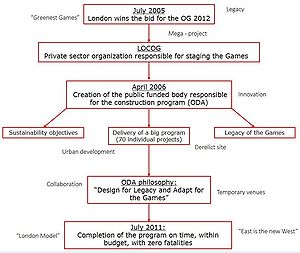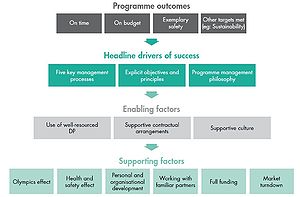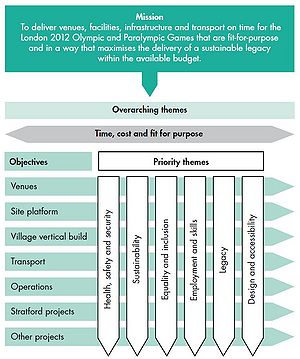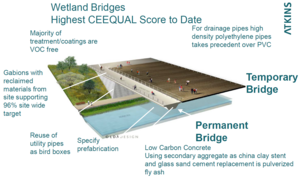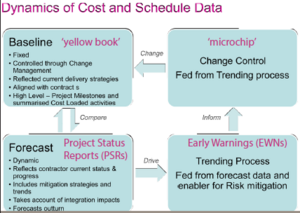Olympic Games London 2012: When the client strives for innovation (The London model)
(→Context) |
|||
| Line 21: | Line 21: | ||
The final cost of £6.8 billion was well within the estimation of 2007 and the programme was completed in July 2011, 13 months before the games started on 27th July 2012, providing LOCOG with sufficient time to check the venues and infrastructure for compliance with the main guidelines, as well as to prepare themselves for the conduction of the Games [5]. Additionally, as the planning and management process was considered successful even before the delivery of the venues and won various industrial awards for excellence, the need to create a documentation for replicability in future projects and programmes arose. Following that, ODA decided to create a series of Learning Legacy documents serving this scope and simultaneously contributing in government’s vision of leaving a legacy after the Games. | The final cost of £6.8 billion was well within the estimation of 2007 and the programme was completed in July 2011, 13 months before the games started on 27th July 2012, providing LOCOG with sufficient time to check the venues and infrastructure for compliance with the main guidelines, as well as to prepare themselves for the conduction of the Games [5]. Additionally, as the planning and management process was considered successful even before the delivery of the venues and won various industrial awards for excellence, the need to create a documentation for replicability in future projects and programmes arose. Following that, ODA decided to create a series of Learning Legacy documents serving this scope and simultaneously contributing in government’s vision of leaving a legacy after the Games. | ||
| + | [[File:Programme_Overview.JPG|300px|thumb|center||sub|Figure 5 - Programme overview]] | ||
== Challenge == | == Challenge == | ||
Revision as of 01:29, 29 September 2015
Contents |
Abstract
On July 2006, when London won the fight to stage the 2012 Summer Olympics, the Olympic Deliver Authority (ODA) and its Delivery Partner (CLM) were pledged to deliver the "Greenest Games" ever. They managed to deliver the construction project on time, within budget, with zero fatalities and high sustainability outcomes, striving to procure innovative products and solutions from the rest of the supply chain. The outcome of their effort, which was evaluated not only in relation to the conduction of the Games, but also to the urban regeneration of various deprived neighbourhouds and the planning of the future use of the venues, was considered succesful and provided them with great industry awards.
The rewarding aftereffect of the construction management programme was combined with the effort of documenting critical paths of the process (learning legacy), so that future mega projects or other Olympic Games could take advantage of an existing succesful 'London model' and evolve their construction process. Various aspects of the 'London model' will be analysed in this wiki article in respect to the programme management process followed by ODA.
Context
On July 2005, the city of London won a two-way fight against Paris to gain the right to stage the 2012 Summer Olympics, even if "Paris has been the favorite throughout the campaign" [4]. The crucial change in the preferences took place after an impressive presentation by Lord Coe, the bid chairman, who emphasized the cornerstone of the bid for the conduction of the Olympic Games, namely the plans to make this the most sustainable Olympic Games on record and leave a lasting legacy. [4] The momentous day of undertaking the Olympic Games of 2012 simultaneously set a seven year countdown clock ticking for the greatest show on Earth. Following the award of the Olympic Games, the British government immediately created a new publicly funded body, which was established by an act of Parliament in April 2006 [1]. The publicly funded body was responsible to bring the whole construction project into reality and to hand it over to the London Organising Committee of the Olympic Games and Paralympic Games (LOCOG), the private sector organization responsible for staging the Games. More specifically, the Olympic Delivery Authority (ODA), as the name of this body was, had not only to plan and deliver a programme constituted out of 70 individual projects, translated in more than 120 principal contracts, but also to encompass the sustainability objectives and to envision the legacy of the Games. The ODA philosophy may be summarized under the quote: ‘Design for Legacy and Adapt for the Games’ [1].
The initial cost estimation by the British government was £2.4 billion for the whole construction programme. However, after revising different aspects of the programme and carefully planning the process, the ODA budget was set at £8.1 billion in 2007, including approximately £2 billion of contingency. After the initial staffing of the key positions, ODA decided directly to employ a Delivery Partner, CLM, a private sector consortium comprising a partnership from the three parent companies of CH2M Hill, Laing O’Rourke and Mace [1]. Furthermore, ODA had to confront with the major regeneration of a completely derelict and polluted site in Stratford, east London, which was chosen both for the proximity to the city centre of London, but also as an area of deprived neighbourhoods that was about to be developed, not only for the Games, but also for the future.
The efficient collaboration and management skills of both ODA and CLM led to delivering the venues and infrastructure programme on time, within budget and with zero fatalities, but also with several sustainability outcomes, like reduced emissions of greenhouse gases, reduced total waste, recycling during construction, as well as minimised impact of the Games on local flora and fauna [4]. During this process, ODA used procedures to ‘overcome the traditional barriers against using innovative solutions by creating the culture and conditions to embrace creativity and innovation from the supply chain’.
The final cost of £6.8 billion was well within the estimation of 2007 and the programme was completed in July 2011, 13 months before the games started on 27th July 2012, providing LOCOG with sufficient time to check the venues and infrastructure for compliance with the main guidelines, as well as to prepare themselves for the conduction of the Games [5]. Additionally, as the planning and management process was considered successful even before the delivery of the venues and won various industrial awards for excellence, the need to create a documentation for replicability in future projects and programmes arose. Following that, ODA decided to create a series of Learning Legacy documents serving this scope and simultaneously contributing in government’s vision of leaving a legacy after the Games.
Challenge
Main Challenges
The complexity embodied in a system like the construction programme of the Olympic Games is already widely known. Some of the main challenges that every programme management organization will face in the case of the Olympic Games are: [2]
- Crucial importance of completing the construction in a tight, well-defined timescale with an “immoveable deadline”, corresponding to the Opening Ceremony of the Games in July 2012
The Olympic Games are scheduled to start on a specific date, which cannot be postponed. Furthermore, the requirements for venues, capacity, infrastructure, as well as other various facilities (accommodation, transportation, health and care system etc) are already defined and set the limits for the construction programme.
- Scale of the construction: 70 separate projects with significant interdependencies (common services, site logistics etc.)
The requirements related to the conduction of the Games create the necessity for a breakdown structure of the construction programme into separate projects, which are more or less interdependent. Especially in the case of the Olympic Games in London, where the site was surrounded by livable neighbourhoods, the space for logistics was constrained, leading to the conclusion that an efficient integration system of different construction processes had to be carefully planned.
- Wide range of stakeholders with legitimate influence over different parts of the programme
The management of the great amount of stakeholders is another critical part of the construction management process, as conflicting interests may arise, which have to be efficiently solved, so that the whole programme is not delayed through the Domino effect (delay of one part of the construction may lead to many other crucial delays).
Additional Challenges
Apart from the general requirements connected with such an extended, technically and politically challenging programme, the case of the Olympic Games in London created additional parameters that had to be encountered by ODA and their delivery partner CLM. These parameters are either related to the conditions under which the construction programme had to be planned and completed, as well as the objectives for the “Greenest Games” ever and the lasting legacy part that were set from the British authorities. As far as the conditions are concerned, the following points are critical and had to be deeply taken into consideration:
- After the creation of the Olympic Delivery Authority, the body had five years to staff up, procure and deliver around £6 billion of major construction works
- The greater amount of construction had to take place in a largely derelict and polluted site in Stratford, which was expected to be regenerated, meaning that the planning process should target not only in the use of the site for the Games, but to the general urban development of the place for future citizens
- Fixed deadline
Moreover, ODA committed to contribute to the overall London 2012 vision of a broad legacy of economic, social and environmental benefits for London and the UK. This would be accomplished on the one hand through the implementation of sustainability strategies and on the other hand through planning for the future of the Games after their conduction in order to leave a lasting legacy that would evolve not only the UK industry, but also work as an existing successful example for future mega projects or Olympic Games under the British copyright. These commitments and requirements established the need for supplementary targets and objectives, making the programme even more complicated and complex than it was before. All these challenges were solved through innovative decisions and planning processes, which created the base for the generation of the “London model”, which corresponds to the way with which ODA and CLM treated the construction management programme from the commissioning to its delivery through a “transferable delivery-focussed governance model”[6].
Solution
The way in which ODA dealt with the complexity of the wicked problem that they were responsible of encountering was through a framework of “drivers of success”, that is illustrated in Figure 1 .As stated before, the main objective of the Olympic Delivery Authority was to deliver the construction programme on time, on budget and with no fatalities on record. Additionally, ODA had to complete supplementary objectives, which were combined with the sustainability and legacy requirements. These targets, which constitute the secondary objectives, were described as priority themes and were embedded as a fundamental part of the overall programme governance. Figure 2 includes the primary and secondary objectives (priority themes) of ODA. The ODA followed an early briefing procedure by publishing a strategy, containing specific objectives, targets and principles which had to be fulfilled before the delivery of the construction program. These data were cascaded down to the contractors through the Delivery Partner and were non-negotiable. However, the way to implement them was left to them, strengthening ODA´s philosophy of "loose-tight" management [2].
Headline drivers of success
Following the illustration of figure 1, there were 3 headline drivers of success. Among them, the five key management processes are considered as the most innovative ones and will be analysed further. They consist of the following crucial initiatives: [2]- Up-front planning process
This innovative initiative was expressed through the “yellow book”, which included the definition of the detailed scope, budget, schedule, risk and interfaces of the programme (November 2007). In this way, both the ODA and CLM were stating their targets and every aspect that was closely related to them from the early construction face, so that every stakeholder was informed about the primary and secondary objectives, the ways to deal with uncertainty, risk and many other aspects. The yellow book can be considered as an innovative step for the feedback-disclosure relationship between client and stakeholders in the case of a wicked problem [10]. As David Birch, Head of Programme Controls at CLM, said, “the ‘yellow book’ produced in late 2007 was a key document for everyone on the programme. It formed the basis of our change control. It captured the scope of work that we had to deliver, the cost of that work, the timing of that work, and all the associated risks, assumptions, and exclusions. Everyone from the chief executive down referred to the ‘yellow book’. It was the key document on everyone’s desk.” [8] Furthermore, the strategic plan included in the "yellow book" contributed to the reduction of the budget. [8] This was materialized among others through the following process:
After careful planning, individual projects were selected that were specified as "not useful" for the future and were converted into temporary structures (mostly venues, bridges). Consequently, all the operational and maintenance costs for their use after the conduction of the Games were reduced. As an example, the Wetland bridges, shown in Figure 3 , were designed with a temporary extension, which was then dismantled and reused. The “Yellow book” was transformed into the “Blue book” in November 2009 to account for the various changes in scope that took place since the initial publication [5].- Project and Programme Monitoring Process:
As described before, the whole construction programme was constituted out of many individual projects (scale of a venue). In their effort to have control over each and every individual project, ODA together with CLM followed the Work Breakdown Structure (WBS) [1]. According to this method, every complex system of the programme was analyzed into specific projects. The Tier 1 contractors of each project had to provide very detailed information on progress, budget position, future programme etc. on a monthly basis [2]. The Delivery Partner was responsible to review the monthly results together with the contractors and create an overall programme review, which was then discussed between the senior managers, involving the ODA and CLM. In general, the contractors were subject to a very rigorous audit, which sometimes led to complaints that the whole process was more a bureaucratic than a management process [2].
- Problem Resolution Process
When a problem was tracked down either from the Tier one contractors, or from CLM, the process of seeking solutions was initiated, typically between CLM and the corresponding Tier one contractor. ODA put a lot of effort on the "best solution" process, even if it required sometimes more time to be identified [2]. The appropriate example to enlighten this philosophy is the Velodrome construction. Engineers noticed that the initial incumbent steel roof design which was proposed as a solution for a self-supporting roof was too heavy. After informing the ODA through the Tier one contractor and CLM, ODA provided time for an evaluation of different possibilities, that way contributing to the innovative solution of a tensioned cable. Moreover, through the change of the contract type from target price with pain/gain to fixed price (will be explained later), ODA managed to take over the risk of overcoming the budget and replaced the possible loss of safety or security of the contractor.[2]
- Change Management Process
- Integration Management Process
In such a complex project like the Olympic Games in London, integration was more than essential in every different part of the life cycle of the program, from the planning and design until the operational handover [5]. Even if there where several aspects and parameters of integration, there were two key elements defining the management process followed, the issue identification and issue resolution [1]. Especially at the program level, important techniques were required to deal with cross-project interfaces and avoid the bow-wave effect of delay. The interdependencies of adjacent projects were monitored from CLM through the "Design Interface Schedule" system, which could define and predict the impact of one change in the design of one element (for example venue) on other parts of the programme [5]. Moreover, CLM appointed an Integration team to manage the hand-over of project domains to the various contractors [8]. The Logistics planning process was also carefully thought, even if not adequately sufficient, from CLM, as they created a Logistics team to transport people and deliver materials. This was a smart idea to avoid on-site conflicts and between contractors due to the urgent need for space. Laing O'Rourke took advantage of its experience on the Heathrow Terminal 5 project.
Enabling factors
Moreover, crucial enabling factors created the conditions for the success drivers to work efficiently. These factors are concluded in the following points:
- Use of well-resourced Delivery Partner
- Supportive contractual arrangements (The Athletes’ Village example)
- Supportive culture
Last but not least, supporting factors like the Olympics effect, namely the prestige of the Olympic games which was a driving motivating force for the whole supply chain and stakeholder group, or the full funding due to the fact that the project was mostly publicly funded, contributed in a respectful percentage on the positive outcome of the construction programme. Moreover, initiatives like the design of some venues for temporary use, so that they could then be transported in other places in the UK were considered as fully efficient in bringing into reality the vision of the future of the Games.
Implication
Not finished yet(the author)
Annotaded bibliography
Not finished yet (the author)




